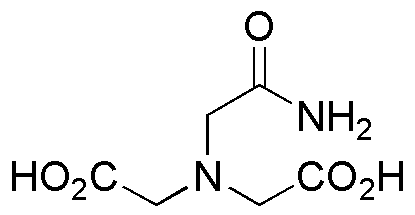N-(2-Acetamido)-2-iminodiacetic acid is widely utilized in research focused on:
- Biochemical Research: This compound serves as a chelating agent in various biochemical assays, helping to stabilize metal ions in enzymatic reactions, which is crucial for studying enzyme kinetics.
- Pharmaceutical Development: Its ability to form stable complexes with metal ions makes it valuable in drug formulation, particularly in enhancing the solubility and bioavailability of certain pharmaceuticals.
- Analytical Chemistry: Used in chromatographic techniques, it aids in the separation and analysis of complex mixtures, providing accurate results in quality control processes.
- Environmental Science: This compound is applied in the remediation of heavy metal contamination in water, effectively binding to harmful metals and facilitating their removal.
- Food Industry: It is utilized as a food additive to improve the stability of certain nutrients by preventing metal-induced degradation, thus enhancing the shelf life of food products.
General Information
Properties
Safety and Regulations
Applications
N-(2-Acetamido)-2-iminodiacetic acid is widely utilized in research focused on:
- Biochemical Research: This compound serves as a chelating agent in various biochemical assays, helping to stabilize metal ions in enzymatic reactions, which is crucial for studying enzyme kinetics.
- Pharmaceutical Development: Its ability to form stable complexes with metal ions makes it valuable in drug formulation, particularly in enhancing the solubility and bioavailability of certain pharmaceuticals.
- Analytical Chemistry: Used in chromatographic techniques, it aids in the separation and analysis of complex mixtures, providing accurate results in quality control processes.
- Environmental Science: This compound is applied in the remediation of heavy metal contamination in water, effectively binding to harmful metals and facilitating their removal.
- Food Industry: It is utilized as a food additive to improve the stability of certain nutrients by preventing metal-induced degradation, thus enhancing the shelf life of food products.
Documents
Safety Data Sheets (SDS)
The SDS provides comprehensive safety information on handling, storage, and disposal of the product.
Product Specification (PS)
The PS provides a comprehensive breakdown of the product’s properties, including chemical composition, physical state, purity, and storage requirements. It also details acceptable quality ranges and the product's intended applications.
Certificates of Analysis (COA)
Search for Certificates of Analysis (COA) by entering the products Lot Number. Lot and Batch Numbers can be found on a product’s label following the words ‘Lot’ or ‘Batch’.
*Catalog Number
*Lot Number
Certificates Of Origin (COO)
This COO confirms the country where the product was manufactured, and also details the materials and components used in it and whether it is derived from natural, synthetic, or other specific sources. This certificate may be required for customs, trade, and regulatory compliance.
*Catalog Number
*Lot Number
Safety Data Sheets (SDS)
The SDS provides comprehensive safety information on handling, storage, and disposal of the product.
DownloadProduct Specification (PS)
The PS provides a comprehensive breakdown of the product’s properties, including chemical composition, physical state, purity, and storage requirements. It also details acceptable quality ranges and the product's intended applications.
DownloadCertificates of Analysis (COA)
Search for Certificates of Analysis (COA) by entering the products Lot Number. Lot and Batch Numbers can be found on a product’s label following the words ‘Lot’ or ‘Batch’.
*Catalog Number
*Lot Number
Certificates Of Origin (COO)
This COO confirms the country where the product was manufactured, and also details the materials and components used in it and whether it is derived from natural, synthetic, or other specific sources. This certificate may be required for customs, trade, and regulatory compliance.


